I've used the FFT data from the Analyser node using the getByteFrequencyData method in the Web Audio API to create a spectrum visualizer as shown below:

In this instance I have 256 bins of data. What exactly do the numbers in this correspond to? Is it the decibel level of each frequency component. If so how do I know what the value of the frequency of each bin corresponds to?
I would like to know so I can experiment in building a graphic eq and so would like to know at which points to indicate the filter bands. Ideally I'd like to represent frequencies from 20Hz to 20kHz and plot intervals between those accordingly.
Thanks for any help.


